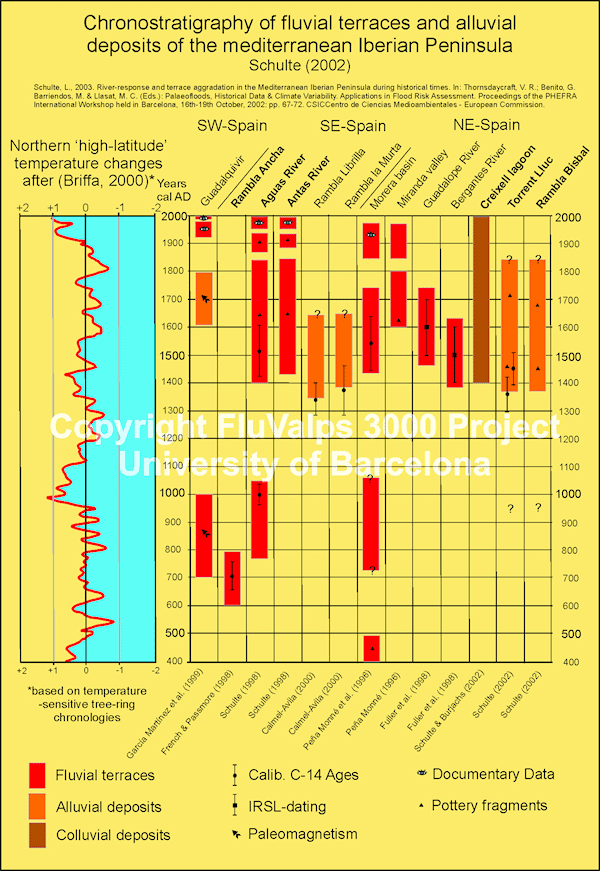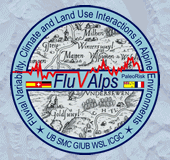Holocene fluvial environments in south-eastern and north-eastern Spain
| Investigators: | Lothar Schulte, Francesc Burjachs, Juan Carlos Peña |
| Period: | 1998-2001 |
| Funding: | Catalan Government (FI/96-1.255; CIRIT), Institute of Catalan Studies |
Results
Mediterranean fluvial environments respond sensitively to past changes in climate, physiographic conditions and human activity. Chronosequences of river terraces and alluvial deposits were established using morphologic, sedimentological and pedologic criteria, 14C- and 210Pb-dating techniques, historical data and pottery fragments. The goal of this study addresses the fluvial dynamic of several river systems focusing on the Vera basin and the lower Penedes basin over the last 1600 years.
The undertaken research of the valley bottoms of the Vera and Penedes basins show important changes regarding the Holocene fluvial environments. The river terraces, alluvial and colluvial deposits result form different periods of fluvial erosion and aggradation. The origin of the fluvial terrace H1 in the Vera basin is climatically induced, although the Versilian transgression may have played an important role. Soil and travertine formation (9.300 70 yr B.P.; U/Th) can be ascribed to more humid climate conditions during the early Holocene (Schulte and Julià, 2001). Historical terrace deposition in the Vera basin occurred during the early Middle Ages, the Little Ice Age and in the 20th century. The erosion of a terrace generation and the accumulation of the next unit represent important morphodynamic changes, particularly an increase in flood magnitude and frequency. The deposition of the point bar deposits point to a meandering river system. Periods of sparse or moderate floods are characterised by stability or minor migration of the main channels.
The installation of the early Middle Ages terraces might be attributed to climatic factors. It can be concluded from the archaeological and historical data that this terrace formation was not caused by human impact. During the late Visigothic and early Arabian Periods, population density was low and agriculture was based on subsistence production. Pollen profiles from the Almería and Alicante Provinces indicate a maximum aridity at the beginning of the Middle Ages (Burjachs et al., 1997). In contrast, human interference in the landscape related to land-use changes during the Christian conquest and the expulsion of the Muslims of the 16th c. may have played a certain role in river dynamics (terraces H3 in the Aguas, terrace H2 in the Antas river). The correlation between the river terrace accumulation in the Vera basin and the flood frequency series of the Spanish Mediterranean coast (Barriendos and Martin-Vide, 1998), indicates that the aggradation of the terrace unit started at the beginning of the Little Ice Age and not during the major peaks of flood frequency around 1600, 1780 and 1850 A.D. However, the youngest small-size terraces of the 20th c. can be correlated with the secondary peaks around 1900 AD and the end of the 40´s.
In the small-size catchments studied in Northeast Spain, human impact has led to increased surface run-off causing drastic alluviation and colluviation in the valley bottoms since the end of the 14th c., particularly during periods of maximum woodland clearance of the 15th c. Iberian, Phoenician and Roman pottery fragments in the upper part of the organic soil also demonstrate land-use during historical time, although no alluvial or colluvial deposits related to these periods were found. During the Roman Period intensive land-use (viniculture, olive groves, and wheat) were restricted to the lowlands of the Penedes basin. In contrast, the modern age woodland clearance affected the slopes of the surrounding mountains and led probably in this way to increased surface runoff and soil erosion. Similar to the findings of the Vera basin, the morphological processes correlate with the beginning of the Little Ice Age (figure 1).

Figure 1: Chronostratigraphy of fluvial terraces and alluvial deposits of the mediterranean Iberian Peninsula (L. Schulte (2002))
To find out the influence of climate or human control on fluvial processes in both study areas it is necessary to establish correlations with other Mediterranean rivers. Figure 1 shows a 1600-year stratigraphy of 13 fluvial catchments of Southwest, Southeast and Northeast Spain, studied by this research and by various authors (García Martinez et al., 1999; French and Passmore, 1998; Calmel-Avila, 2000; Peña Monné et al., 1996; Fuller et al., 1998; Schulte et al., 2000). According to the stratigraphy, fluvial terraces were accumulated in some catchments during the Early Medieval Ice Advance (6th - 10th century), whereas fluvial activity during the Medieval Optimum was insignificant. However, in nearly all river systems sedimentation of fluvial deposits occurred during the Little Ice Age. The aggradation processes mostly started at the onset of this global climate period. The increased flood-events can be related to the southward shift of the Northern Hemisphere westerlies during the Little Ice Age.
Publications
Schulte, L., 2003. River-response and terrace aggradation in the Mediterranean Iberian Peninsula during historical times. In: Thornsdaycraft, V. R.; Benito, G.; Barriendos, M. & Llasat, M. C. (Eds.): Palaeofloods, Historical Data & Climate Variability. Applications in Flood Risk Assessment. Proceedings of the PHEFRA International Workshop held in Barcelona, 16th-19th October, 2002 (67-72). CSIC-Centro de Ciencias Medioambientales - European Comisión, Programme on Environment and Sustainable Development, Madrid. (pdf)
Burjachs-Casas, F., Schulte, L., 2003. El paisatge vegetal del Penedès entre la Prehistòria i el Món Antic. In: Gitart, J., Palet, J.M., Prevosti, M. (Eds.). Paisatges antics a la Mediterrània i a la Cossetania oriental. pp. 249-254.
Schulte, L., 2002. Climatic and human influence on river systems and glacier fluctuations in southeast Spain. Quaternary International 93-94, 85-100.
Schulte, L., 2002. Extended abstract: Quaternary evolution of the Vera basin (SE-Iberian Peninsula). A reconstruction of paleoclimatic fluctuations from morphological and pedological studies. In: Schulte, L. Evolución cuaternaria de la depresión de Vera y de Sorbas oriental (SE-Península Ibérica): reconstrucción de las fluctuaciones paleoclimáticas a partir de estudios morfológicos y edafológicos. Publicaciones de la Universidad de Barcelona, Barcelona. pp. 1-9. (pdf)
Schulte, L., 2002. Evolución cuaternaria de la depresión de Vera y de Sorbas oriental (SE-Península Ibérica): reconstrucción de las fluctuaciones paleoclimáticas a partir de estudios morfológicos y edafológicos. Publicaciones de la Universidad de Barcelona, Barcelona. 251 pp.
Schulte, L., 2002. The influence of climate change and human dynamics on fluvial environments in southeastern and northeastern Spain over the last 1500 years. In: Fouache, E. (ed.). International Conference on Environmental Dynamics and History in Mediterranean areas. IAG, Paris, p.79.
Schulte, L., Gómez Ortiz, A., Passmore, P., 2000. Sobre los supuestos restos periglaciares pleistocenos en los llanos del sureste de la Península Ibérica. In: Peña Monné, J.L., Sánchez-Fabre, M., Lozano, M.V. (Eds.), Procesos y formas periglaciares en la montaña Mediterránea. I.P.A.-España, Teruel, pp. 281-297.
Schulte, L. et al. 2019.
Integration of multi-archive datasets towards the development of a four-dimensional paleoflood model in alpine catchments.
Global and Planetary Change 180, 66-88.
Peña, J.C.; Schulte, L., 2020.
Simulated and reconstructed atmospheric variability and their relation with large Pre-industrial summer floods in the Hasli-Aare catchment (Swiss Alps) since 1300 CE.
Global and Planetary Change 190, 103191.
Schulte, L. et al., 2019.
Pluridisciplinary analysis and multi-archive reconstruction of paleofloods: societal demand, challenges and progress.
Global and Planetary Change 177, 225-238.
Blöschl, G. et al. 2020.
Current European flood-rich period exceptional compared with past 500 years.
Sánchez-García et al. 2019.
500-year flood history in the arid environments of south-eastern Spain. The case of the Almanzora River.
Global and Planetary Change, 102987.
Schulte, L. et al. 2015.
A 2600-year history of floods in the Bernese Alps, Switzerland: frequencies, mechanisms and climate forcing.
Hydrology and Earth System Sciences 19, 3047-3072.
Peña, J.C. et al. 2015.
Influence of solar forcing, climate variability and atmospheric circulation patterns on summer floods in Switzerland.





